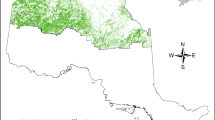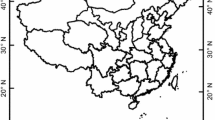Abstract
This paper quantified carbon budget in the past 30 years (1981–2010) and identified the impact of land cover change on carbon dynamics using vegetation integrated simulator for trace gases (VISIT) model. North Korea was converted from carbon sink to source with 10.72 ± 5.18 Tg C yr−1 of net ecosystem production (NEP) in the 1980s, 3.00 ± 7.96 Tg C yr−1 in the 1990s, and −0.46 ± 5.13 Tg C yr−1 in the 2000s. NEP in South Korea was 10.55 ± 1.09 Tg C yr−1 in the 1980s, 10.47 ± 7.28 Tg C yr−1 in the 1990s, and 6.32 ± 5.02 Tg C yr−1 in the 2000s, showing a gradual decline. In North Korea, NEP was decreased by 0.52 Tg yr−1 in the 1990s due to reduction of forest, and increased by 0.36 Tg yr−1 in the 2000s due to expansion of cropland. In South Korea, it was decreased by 0.24 Tg yr−1 in the 1990s as urban and built-up area expanded, and increased by 0.04 Tg yr−1 in the 2000s with the expansion of forest. These results suggest the importance of forest and land cover management against deforestation for ensuring national carbon balance.
Similar content being viewed by others
References
Acutis M, Donatelli M (2003) ‹i› SOIL‹/i› PAR 2.00: software to estimate soil hydrological parameters and functions. Eur J Agron 18:373–377
Bachelet D, Lenihan JM, Daly C, Neilson RP, Ojima DS, Parton WJ (2001) MC1: a dynamic vegetation model for estimating the distribution of vegetation and associated carbon, nutrients, and water-technical documentation. Version 1.0. 508. pp 1–36
Buck AL (1981) New equations for computing vapor pressure and enhancement factor. J Appl Meteorol 20:1527–1532
Cao M, Prince SD, Shugart HH (2002) Increasing terrestrial carbon uptake from the 1980s to the 1990s with changes in climate and atmospheric CO2. Global Biogeochem Cy 16:17_1–17_11
Chae N (2011) Annual variation of soil respiration and precipitation in a temperate forest (Quercus serrata and Carpinus laxiflora) under East Asian monsoon climate. J Plant Biol 54:101–111
Chen G-S, Tian H-Q (2007) Land use/cover change effects on carbon cycling in terrestrial ecosystems. Chinese J Plant Ecol (chinese version) 31:189–204
Choi I-H, Woo J-C (2007) Developmental process of forest policy direction in korea and present status of forest desolation in north korea. J Forest Sci 23:14
Choi SD, Lee K, Chang YS (2002) Large rate of uptake of atmospheric carbon dioxide by planted forest biomass in Korea. Global Biogeochem Cy 16:36_31–36_35
Choi S, Lee W-K, Kwak D-A, Lee S, Son Y, Lim J-H, Saborowski J (2012) Predicting forest cover changes in future climate using hydrological and thermal indices in South Korea. Climate Res 49:229
Climate Change Information Center (CCIC) (2013) Perspectives of the Korean peninsula’s climate change report (in korean). 11-1360000-000861-01
DeFries R, Field C, Fung I, Collatz G, Bounoua L (1999) Combining satellite data and biogeochemical models to estimate global effects of human-induced land cover change on carbon emissions and primary productivity. Global Biogeochem Cy 13:803–815
Dixon RK, Solomon A, Brown S, Houghton R, Trexier M, Wisniewski J (1994) Carbon pools and flux of global forest ecosystems. Science 263:185–190
Food and Agriculture Organization (FAO) UNESCO (1971-1981) Soil map of the world. Rome:1–10
Hong J, Shim C, Lee M, Baek G, Song W, Jeon S, Park Y (2011) Net Primary Production Changes over Korea and Climate Factors. Korean J Remote Sens 27:467–480
Houghton R (1999) The annual net flux of carbon to the atmosphere from changes in land use 1850-1990*. Tellus B 51:298–313
Houghton RA (2003) Revised estimates of the annual net flux of carbon to the atmosphere from changes in land use and land management 1850–2000. Tellus B 55:378–390
Houghton R, House J, Pongratz J, van der Werf G, DeFries R, Hansen M, Le Quéré C, Ramankutty N (2012) Carbon emissions from land use and land-cover change. Biogeosciences 9:5125–5142
Ito A, Oikawa T (2002) A simulation model of the carbon cycle in land ecosystems (Sim-CYCLE): a description based on drymatter production theory and plot-scale validation. Ecol Model 151:143–176
Ito A, Saigusa N, Murayama S, Yamamoto S (2005) Modeling of gross and net carbon dioxide exchange over a cool-temperate deciduous broad-leaved forest in Japan: analysis of seasonal and interannual change. Agr Forest Meteorol 134:122–134
Ito A (2008) The regional carbon budget of East Asia simulated with a terrestrial ecosystem model and validated using AsiaFlux data. Agr Forest Meteorol 148:738–747
Karjalainen T, Pussinen A, Liski J, Nabuurs G-J, Eggers T, Lapveteläinen T, Kaipainen T (2003) Scenario analysis of the impacts of forest management and climate change on the European forest sector carbon budget. Forest Policy Econ 5:141–155
Kim SN, Lee WK, Shin KI, Kafatos M, Seo DJ, Kwak HB (2010) Comparison of spatial interpolation techniques for predicting climate factors in Korea. Forest Sci Technol 6:97–109
Kong WS (2002) Biogeographic feature of north korean ecosystem. Euro Env Imp Assess 11:157–172
Korea Forest Service (2009) Statistical Yearbook of Forestry 2008. Korea Forest Service, Seoul, pp 30–32 (in Korean).
Korea Forest Service (2010) Annual report of trend in forest and foresty. 11-1400000-000196-10, Seoul, pp 4–5, 655 (in Korean).
Korea Forest Service (2013) Statistical Yearbook of Forestry 2013. 11-1400000-000001-10, Seoul, pp 44, 422, 490 (in Korean).
Kwon H, Park T-Y, Hong J, Lim J-H, Kim J (2009) Seasonality of Net Ecosystem Carbon Exchang in Two Major Plant Functional Types in Korea. Asia-Pac J Atmos Sci 45:149–163
Lee M, Lee W-K, Song C, Lee J, Choi H, Kim T (2007) Spatiotemporal change prediction and variability of temperature and precipitation. J GIS Assoc Korea 15:267–278
Lee S (2004) Situation of degraded forest land in DPRK and strategies for forestry cooperation between south and north korea. J Agr Life Sci 38:101–113
Li X, Yi MJ, Son Y, Park PS, Lee KH, Son YM, Kim RH, Jeong MJ (2011) Biomass and carbon storage in an age-sequence of Korean pine (Pinus koraiensis) plantation forests in central Korea. J Plant Biol 54:33–42
Lim J, Shin J, Jin G, Chun J, Oh J (2003) Forest stand structure, site characteristics and carbon budget of the Kwangneung natural forest in Korea. Korean J Agr Forest Meteorol 5:101–109
Noh NJ, Son Y, Lee SK, Yoon TK, Seo KW, Kim C, Lee W-K, Bae SW, Hwang J (2010) Influence of stand density on soil CO2 efflux for a Pinus densiflora forest in Korea. J Plant Res 123:411–419
Reidsma P, Tekelenburg T, Van den Berg M, Alkemade R (2006) Impacts of land-use change on biodiversity: an assessment of agricultural biodiversity in the European Union. Agr Ecosyst Environ 114:86–102
Running SW, Thornton PE, Nemani R, Glassy JM (2000) Global terrestrial gross and net primary productivity from the Earth Observing System. in Methods in ecosystem science, Springer, New York, pp 44–57
Sala OE, Chapin FS, Armesto JJ, Berlow E, Bloomfield J, Dirzo R, Huber-Sanwald E, Huenneke LF, Jackson RB, Kinzig A (2000) Global biodiversity scenarios for the year 2100. Science 287:1770–1774
Sasai T, Ichii K, Yamaguchi Y, Nemani R (2005) Simulating terrestrial carbon fluxes using the new biosphere model “biosphere model integrating eco-physiological and mechanistic approaches using satellite data” (BEAMS). J Geophys Res:Biogeo(2005–2012) 110
Sasai T, Saigusa N, Nasahara KN, Ito A, Hashimoto H, Nemani R, Hirata R, Ichii K, Takagi K, Saitoh TM (2011) Satellite-driven estimation of terrestrial carbon flux over Far East Asia with 1-km grid resolution. Remote Sens Environ 115:1758–1771
Schaap MG, Leij FJ, van Genuchten MT (2001) Rosetta: A computer program for estimating soil hydraulic parameters with hierarchical pedotransfer functions. J Hydrol 251:163–176
Son Y, Seo KY, Kim RH, Kim J (2006) Soil respiration and FDA hydrolysis following conversion of abandoned agricultural lands to natural vegetation in central Korea. J Plant Biol 49:231–236
South Korean Ministry of Environment (2014) http://egis.me.go.kr/ba/grdCoverIntroPage.do?mode=3.
Task GSD (2000) Global Soil Data Products CD-ROM (IGBP-DIS), CD-ROM, International Geosphere-Biosphere Programme, Data and Information System, Potsdam, Germany. Available from Oak Ridge National Laboratory Distributed Active Archive Center, Oak Ridge, Tennessee, USA
Van der Werf GR, Morton DC, DeFries RS, Olivier JG, Kasibhatla PS, Jackson RB, Collatz GJ, Randerson J (2009) CO2 emissions from forest loss. Nat Geosci 2:737–738
Verma M, Friedl M, Richardson A, Kiely G, Cescatti A, Law B, Wohlfahrt G, Gielen B, Roupsard O, Moors E (2014) Remote sensing of annual terrestrial gross primary productivity from MODIS: an assessment using the FLUXNET La Thuile data set. Biogeosciences 11:2185–2200
Yoo S, Kwak D-A, Cui G, Lee W-K, Kwak H, Ito A, Son Y, Jeon S (2013) Estimation of the ecosystem carbon budget in South Korea between 1999 and 2008. Ecol Res 28:1045–1059
Author information
Authors and Affiliations
Corresponding author
Electronic supplementary material
Rights and permissions
About this article
Cite this article
Cui, G., Lee, WK., Kim, D. et al. Estimation of forest carbon budget from land cover change in South and North Korea between 1981 and 2010. J. Plant Biol. 57, 225–238 (2014). https://doi.org/10.1007/s12374-014-0165-3
Received:
Accepted:
Published:
Issue Date:
DOI: https://doi.org/10.1007/s12374-014-0165-3




